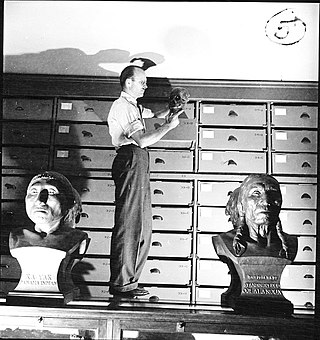Related Research Articles

Charles Greeley Abbot was an American astrophysicist and the fifth secretary of the Smithsonian Institution, serving from 1928 until 1944. Abbot went from being director of the Smithsonian Astrophysical Observatory, to becoming Assistant Secretary, and then Secretary of the Smithsonian Institution over the course of his career. As an astrophysicist, he researched the solar constant, research that led him to invent the solar cooker, solar boiler, solar still, and other patented solar energy inventions.

John Reed Swanton was an American anthropologist, folklorist, and linguist who worked with Native American peoples throughout the United States. Swanton achieved recognition in the fields of ethnology and ethnohistory. He is particularly noted for his work with indigenous peoples of the Southeast and Pacific Northwest.

Frank Alexander Wetmore was an American ornithologist and avian paleontologist. He was the sixth Secretary of the Smithsonian Institution. He was also an elected member of both the American Philosophical Society and the United States National Academy of Sciences.

William Henry Holmes, known as W. H. Holmes, was an American explorer, anthropologist, archaeologist, artist, scientific illustrator, cartographer, mountain climber, geologist and museum curator and director.
The Robert J. Terry Anatomical Skeletal Collection is a collection of some 1,728 human skeletons held by the Department of Anthropology of the National Museum of Natural History of the Smithsonian Institution, Washington, D.C., United States.

Jane Ellen Buikstra is an American anthropologist and bioarchaeologist. Her 1977 article on the biological dimensions of archaeology coined and defined the field of bioarchaeology in the US as the application of biological anthropological methods to the study of archaeological problems. Throughout her career, she has authored over 20 books and 150 articles. Buikstra's current research focuses on an analysis of the Phaleron cemetery near Athens, Greece.
Dr. Michael Finnegan is a retired Professor of anthropology at Kansas State University and is one of the nation's leading forensic anthropology experts. In 2005, he was named a Distinguished Fellow of the American Academy of Forensic Sciences. He holds a Ph.D. in Anthropology from the University of Colorado and held a postdoctoral fellowship at the Smithsonian Institution, studying paleopathology and non-metric variation for population studies and forensic science application. He is a Fellow and past Vice President of the American Academy of Forensic Sciences; a Diplomate, and past President, of the American Board of Forensic Anthropology, Inc.;and is a recipient of the "Kansas Attorney General's Certificate of Merit" in recognition of outstanding service rendered to law enforcement in and for the State of Kansas by a private citizen.
Waldo Rudolph Wedel was an American archaeologist and a central figure in the study of the prehistory of the Great Plains. He was born in Newton, Kansas to a family of Mennonites.

Richard Kurin, an American cultural anthropologist, museum official and author, is the Acting Provost and Under Secretary for Museums and Research at the Smithsonian Institution. He is a key member of the senior team managing the world's largest museum and research complex with 6,500 employees and a $1.4 billion annual budget, caring for more than 139 million specimens, artifacts and artworks, working in 145 countries around the globe, hosting some 30 million visitors a year, and reaching hundreds of millions online and through the Smithsonian's educational programs and media outreach. Kurin is particularly responsible for all of the national museums, scholarly and scientific research centers, and programs spanning science, history, art and culture.

Smithsonian Libraries and Archives is an institutional archives and library system comprising 21 branch libraries serving the various Smithsonian Institution museums and research centers. The Libraries and Archives serve Smithsonian Institution staff as well as the scholarly community and general public with information and reference support. Its collections number nearly 3 million volumes including 50,000 rare books and manuscripts.
Joe Ben Wheat (1916–1997) was an American archaeologist, curator, teacher, and author known for his expertise on woven textiles produced by the Navajo and other Native American tribes in Arizona, New Mexico, and Colorado. His research also focused on Mogollon, Anasazi, Great Plains Paleo-Indian, and African Paleolithic archaeology.
George R. Milner is an American archaeologist in the Department of Anthropology at The Pennsylvania State University. He has done archaeological research on sites encompassing a range of time periods in Illinois, Missouri, Wisconsin, and Kentucky, and has also worked in Egypt and Saipan (Micronesia). He has worked with prehistoric and historic human skeletal remains from eastern North America, Denmark, and Egypt. By using modern samples of known age from the United States, Switzerland, and Portugal, he has helped refine skeletal age estimation techniques.
Richard L. Jantz is an American anthropologist. He served as the director of the University of Tennessee Anthropological Research Facility from 1998–2011 and he is the current Professor Emeritus of the Department of Anthropology at the University of Tennessee, Knoxville. His research focuses primarily on forensic anthropology, skeletal biology, dermatoglyphics, anthropometry, anthropological genetics, and human variation, as well as developing computerized databases in these areas which aid in anthropological research. The author of over a hundred journal articles and other publications, his research has helped lead and shape the field of physical and forensic anthropology for many years.

Douglas W. Owsley is an American anthropologist who is head of Physical Anthropology at the Smithsonian's National Museum of Natural History (NMNH). He is regarded as one of the most prominent and influential archaeologists and forensic anthropologists in the world in some popular media. In September 2001, he provided scientific analysis at the military mortuary located at Dover Air Force Base, following the 9/11 attack in Washington, D.C. The following year, the US Department of Defense honored him with the Commander's Award for Civilian Service for helping in the identification of 60 federal and civilian victims who died when American Airlines Flight 77 hit the Pentagon.

John Canfield Ewers was an American ethnologist and museum curator. Known for his studies on the art and history of the American Plains Indians, he was described by The New York Times as one of his country's "foremost interpreters of American Indian culture."
Kari Bruwelheide is an American archaeologist and anthropologist. She is known for her work as a physical anthropologist, bioarchaeologist, and forensic anthropologist at the Smithsonian Institution's National Museum of Natural History.

Thomas Dale Stewart was a founder of modern forensic anthropology and a major contributor to most areas of human skeletal biology, paleopathology, and related areas of physical anthropology.
Osteoware is a free data recording software for human skeletal material that is managed through the Smithsonian Museum of Natural History. It is used by biological anthropologists to document data relevant to research and forensic applications of human skeletal remains in a standardized and consistent way. It has influenced other skeletal recording software, and has been successfully used at the Smithsonian for collecting data relevant to biological anthropology. Osteoware is the only free, individual-use software for the collection of data on skeletal material in anthropology.
Carla J. Dove is an American researcher who specializes in identifying birds that have gotten trapped in airplane engines, known as bird strikes. She is currently the Program Manager for Feather Identification Lab in the Division of Birds at the National Museum of Natural History. Her work helps promote wildlife safety, as well as pave the way for the development of preventative measures that will decrease the chance of wildlife impacting airplanes. She has published over 40 articles on her research so far.
Lucile Eleanor St. Hoyme was an American biological anthropologist who conducted research related to human variation, bioarcheology, and paleopathology. St. Hoyme served as an Assistant Curator in the Department of Anthropology at the National Museum of Natural History. St. Hoyme analyzed human remains excavated from the John Kerr Reservoir Basin using a new bioarcheological approach combining data from other disciplines. Beyond her work with the Smithsonian collections, St. Hoyme also worked on FBI forensic cases in the 1960s with National Museum of Natural History Anthropology Curator J. Lawrence Angel.